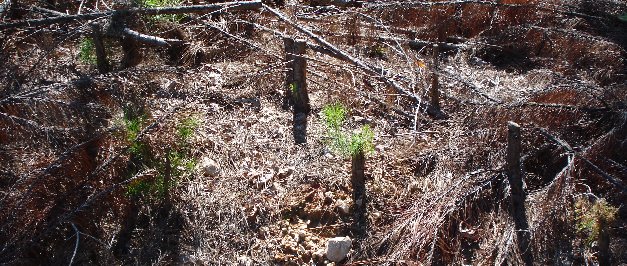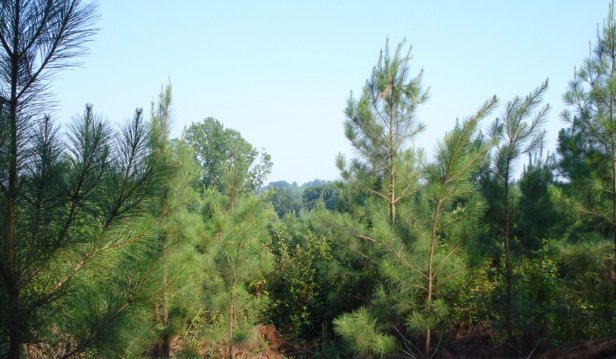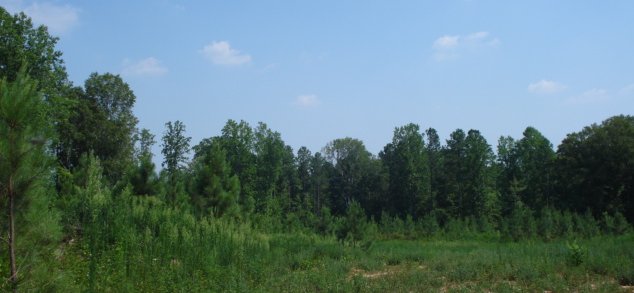Below – sprouts on the loblolly pines recently thinned. Lobolly is one of the few pines that can sprout from a cut stump.

We will get some form of carbon tax and/or carbon trading no matter who becomes president next year. This prospect makes carbon trading a hot topic among forest owners. Forests naturally soak up carbon dioxide and well managed forests do a better job than others.
The best and most elegant solution to problem of CO2 emissions is a simple carbon tax. A carbon tax is the way of minimum government interference in the economy and will provide the maximum benefit because it does not try to pick technologies, techniques, winners or losers. A carbon tax changes the energy equation but lets people decide on the various solutions they thing are best. This is the reason why we won’t get this solution. Politicians hate these kinds of things. It solves the problem and takes away an issue from them. It also is too simple, so they have little or no scope to provide special privileges or breaks to their supporters.
Remember the ethanol debacle? It was a great example of how government can make an experiment with a good idea into a monster than raises food prices worldwide, creates environmental stress all the while costing the taxpayers and consumers money. Expect a lot more of these sorts of things in the next few years. Sorry for the digression.
Below – thinned loblolly pine five-years old

The next best thing to a simple carbon tax is a cap and trade system that sets the rules and then gets out of the way. Ideally the government would auction off the carbon rights and let those who wanted to use them figure out the distribution. Of course nothing is so simple. You have to define both carbon producers and carbon sinks (takes CO2 out of the air). This is complicated because the carbon cycle is one of the biggest natural processes on earth. Billions of tons of carbon are cycled through the atmosphere every day and only a very small percentage is influenced by human activities. We don’t want to allow people to get benefits or penalties just for being near a particular natural process. On the other hand, human choices can significantly affect how much carbon natural processes take out or put in. Nowhere is this truer than in forestry.
Forest destruction in places like Indonesia and Brazil put more CO2 in the air than all our transportation. On the other hand, growing forests in North America have pulled that amount out. This is a big deal, but hard to measure and assessment is complicated even more by the nature of nature. An old, established forest is near equilibrium, i.e. as much CO2 is put into the air from decay and respiration as is taken out by photosynthesis. (This is the way it has to be. The natural carbon account must balance. W/o CO2 plants cannot grow and life on earth is impossible. More CO2 makes plants grow better and healthier. CO2 is not a type of pollution in the sense we usually think of these things.) Destruction of an established forest puts carbon in the air and the establishment of a new forest takes it out. We don’t want to encourage people to destroy an established forest in order to establish a new one to get credit for the CO2 it would remove.
I have to admit that I am not really sure about this whole carbon sink idea. In the long run forests would be carbon neutral, since carbon absorbed by leaves, needles and wood would be released when those things decomposed. Growing more trees and bigger trees is good from many angles and it would buy us some time, maybe centuries, in limiting greenhouse gasses, but most of what goes into the forest will come out again.
Of course, maybe all we need is time. A fix that holds for more than 100 years could be called a long-term solution. By that time we can hope and expect other technologies to be available.
Below – a wildlife food plot with thinned pines and mature hardwoods in background

How Carbon Credits Work for Forestry
The market for carbon is one just developing and forestry is even at an earlier stage than some others, since forest sinks were specifically excluded from Kyoto. This was/is a serious oversight (although it was not really an oversight but rather a political ploy, IMO, aimed at the U.S.) which is being addressed. This is how it would probably work.
You have to start with a certified forest, so that you can measure the carbon input and carbon output AND a third party can audit it. The landowner must provide proof of ownership, including timber rights, location maps, acreage and management plan. An audit establishes a baseline of all the carbon that is currently stored above ground in stems and branches as well as below ground in roots and soils. The landowner signs a contract, usually for fifteen years, where he agrees to abide by practices that will enhance the forest’s absorption of CO2 so that at the end of the contract there is more carbon stored in the forest at the end of the contract. He is really selling the difference between the baseline carbon levels and the ending levels. Carbon is sold by the ton.
These trades take place on the Chicago Carbon Exchange. Carbon trading is still VOLUNTARY. Buyers are firms interested in good public relations and individuals, many celebrities, who want to shrink their carbon footprints. A mandated cap & trade program would enhance this trading and probably raise prices.
Individual landowners cannot participate in the program, since they would be selling too little carbon to make a profitable sale. Instead they would have to work through an aggregator, who would collect carbon contracts from many landowners and sell them as a unit. Of course, at every step of the way various people like aggregators and brokers are taking their slice, so landowners should not look at the carbon price and think they will get anything like the posted amounts.
Each year the landowner would be paid for the estimated carbon sequestration, with 20% withheld as insurance against a catastrophe that might destroy the forest. The contract would account for planned forestry operations. For example, it would be discounted for a thinning operation near the end of the contract. Of course, a well timed thinning INCREASES total carbon sequestration in the medium and long run, so that is also estimated if done earlier in the contract. At the end of the term there is a reckoning. A final audit determines how much carbon has been soaked up. If it is as estimated the landowner gets the 20% that had been withheld. If there is less than estimated, the landowner doesn’t get the whole amount and if there is more he gets a bonus.
Some landowners see this as free money. They get paid for what they would have done anyway. This is not entirely true. As with any contract, you have to be c careful. The carbon contract acts as a type of easement. It complicates your ability to sell the land unencumbered as well as defacto tying up your ability freely to develop the land during the period of the contract. Still and all, it looks like a good way to pump some money into rural land, compensate landowners for some of those green infrastructure benefits they provide and maybe tip the balance in favor of forestry and against conversion to other uses or development.
I don’t have a contract on my land. I am waiting until I understand the process better. There is no rush. IMO, the price of carbon will go up. I have mixed feeling about the idea of selling credits. It seems a lot like selling indulgences in the medieval church. The carbon credits produced on my land will allow people like Madonna or Al Gore to jet around the world without feeling guilty about the burden they place on the environment. But they will do that anyway. Putting money back into the land is a good idea, no matter the source.
Virginia Tech produced a good background on carbon trading and I have added this one.
